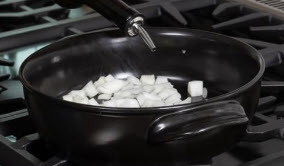Frying pans are the most commonly owned cookware in America. You can use frying pans for so many things. Most people use their frying pans every single day. If you use something every single day, shouldn’t you know everything about it? Let talk about a solid ceramic frying pan.
Do you know what is in your frying pan? Or how it is made and with what material? It is crucial to answer these questions because you should know what is going in your body.
 Those who are concerned with frying pan material buy ceramic cookware and bakeware. What most people don’t know is: ceramic cookware is not typically 100% solid ceramic.
Those who are concerned with frying pan material buy ceramic cookware and bakeware. What most people don’t know is: ceramic cookware is not typically 100% solid ceramic.
Ceramic cookware is often ceramic-coated cookware. Although the outside of the cookware is ceramic, the base is usually a heavy metal. The interior of ceramic coated cookware is usually aluminum, copper, or a mixture of heavy metals.
There are cookware lines that do offer a ceramic-only cookware set and fry pan. Probably the most accessible brand is Xtrema.
Xtrema has been featured on Dr.Axe: Food is Medicine, The National Geographic, The Oprah Magazine, and Time magazine. There is something important about an all-ceramic frying pan.
Do you want to know what is so special about a 100% ceramic frying pan, how to use it, the advantages, and disadvantages? Keep reading to learn more!
All About 100%, Solid Ceramic Frying Pans
Non-Toxic & Healthy
Solid ceramic fry pans are made from 100% ceramics; this means that there are no unnecessary chemicals, materials, or toxins. Teflon frying pan, for example, is used to contain PFOA.
PFOA gave everyone a scare in the past because it has led to health complications. When PFOA is at a high temperature, it releases harmful fumes. This fume contains carcinogens that cause cancer and other serious health problems.
Not only is it free of PFOA, but it is also free of the following materials:
- Metal
- Cadmium
- Led
- PFOA
- PTFE
- Glues
- Polymers Coatings
- Dyes
Even if the pan is heated too hot, it will not release dangerous chemicals into the air or your food. Because it does not contain any metal, solid ceramic fry pans will not flake or chip toxic materials.
Versatile & Durable
All ceramic fry pans are versatile and durable. Consider the material ceramic. Ceramics have been used for centuries. Companies have found a way to bring an age-old cooking method into a modern-day setting. If people used ceramics for years, then there must be something good about it.
Today, solid ceramic cookware is made by using high temperatures. Xtrema triple fires their solid ceramic cookware at 2,500 degrees Fahrenheit. By firing it at this temperature, it increases strength and durability.
100% ceramic cookware can be used with almost all stovetops (minus induction), freezer temps, and table settings. Many use their solid ceramic fry pan to do more than cook! This material allows chefs to use their fry pan to prep, mix, cook, serve, and store their meals!
Heat Conduction & Retention
Ceramics have always been known for their heat conduction and heat retention. When using a solid ceramic fry pan, chefs can cook at lower temperatures because the pan will distribute the heat evenly and effectively.
With this frying pan, you do not have to worry about your food getting cold. Because ceramic is a heat retainer, food will be kept warm even after the pan is off the stove.
How To Use a Solid Ceramic Frying Pan
Solid ceramic fry pans conduct heat very well. The pan does not have to be at a high temperature. Many ceramic cookware companies insist that you only cook at low to medium temperatures. The pan does not require high temperature, and also high temperatures can damage the internal structure of the pan.
To best use a ceramic fry pan, let the pan warm up before cooking. Let the pan warm up before cooking, and it will make cooking much easier and faster.
 Unfortunately, solid ceramic fry pans and ceramic-coated fry pans have different surface structures. Ceramic coatings have a combination of ceramic and a glaze that creates a non-stick material. Ceramic coatings are traditionally non-stick and with a smooth surface. Solid ceramic fry pans are not naturally non-stick. Chefs must always keep their solid ceramic fry pan lightly oiled for a non-stick surface.
Unfortunately, solid ceramic fry pans and ceramic-coated fry pans have different surface structures. Ceramic coatings have a combination of ceramic and a glaze that creates a non-stick material. Ceramic coatings are traditionally non-stick and with a smooth surface. Solid ceramic fry pans are not naturally non-stick. Chefs must always keep their solid ceramic fry pan lightly oiled for a non-stick surface.
Advantages & Disadvantages
Advantages
For starters, a solid ceramic fry pan is non-toxic. As stated previously, this frying pan does not have any harmful chemicals, heavy metals, or unnecessary materials; this is a huge advantage to those that are health-conscious.
Another advantage is that you can use an all-ceramic fry pan almost everywhere! The following appliances and devices are compatible with a solid ceramic fry pan:
- Broiler
- BBQ Grill
- Dishwasher
- Glass Stovetop
- Gas Stovetop
- Freezer
- Microwave
- Oven
- Refrigerator
- Toaster Oven
- Steamer Oven
Not only is this fry pan compatible with many cooking appliances, but it is dishwasher-safe as well!
Ceramic is a durable material; therefore, it is difficult to scratch. According to Xtrema, their ceramic is harder than metal and it can not be scratched by sharp utensils.
Disadvantages
Unlike ceramic glaze, solid ceramic fry pans are not non-stick; this can be a tough adjustment for chefs. It does require extra time cooking because you must warm the pan first and then lightly oil the pan before adding food.
Solid ceramic fry pans should not only be on a low to medium heat setting. A high heat setting may crack or compromise the internal structure of the pan. To avoid damaging pans, use your all-ceramic pan at a low or medium temperature. Also, thaw frozen foods before adding them to a warm pan. And avoid putting warm pans on cold counters or stovetops.
Because all-ceramic fry pans are durable and hefty, you must be careful using them with a glass stovetop. Solid ceramic cookware is compatible with glass stovetops, but it can scratch the stovetop if it slides on the surface.
While 100% ceramic cookware can not be scratched by sharp utensils, these utensils can leave markings and residue behind. It is recommended that chefs use silicone, nylon, wooden, or plastic utensils.
Lastly, customers complain that the handles of an all-ceramic fry pan get extremely hot. In response to this complaint, many cookware companies sell silicone panhandles to avoid accidents and burns.
Is a Solid Ceramic Fry Pan For You?
How do you know if a 100% solid ceramic fry pan is for you? If you care about what materials and chemicals are in your cookware, then this may be the pan for you; if you need a frying pan that is versatile, durable, and strong. Solid ceramic cookware conducts and retains heat very well in comparison to other frying pans.
This fry pan is not for you if you do not have time or patience. Buying an all-ceramic frying pan requires more care and protection than other cookware pieces. You must keep your pan oiled and never too hot. Chefs must also be wary of drastic temperature changes. Dramatic temperature changes can chip or crack your ceramic pan.
What do you think? Will you buy a solid ceramic frying pan? Did this review help you? Let us know!
